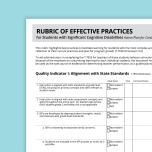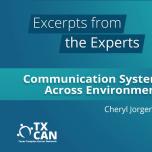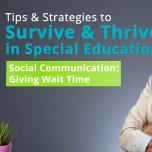Social Communication: Incorporating Communication Devices
In this video, Ayo Jones discusses how to incorporate communication devices into classroom activities. This video aligns with the Rubric of Effective Practices Quality Indicator V: Social Communication.
Related Content

Significant Cognitive Disabilities, Behavior, Instruction, ARD/IEP Supports, Inclusion
Rubric of Effective Practices for Students with Complex Access Needs

Significant Cognitive Disabilities, ARD/IEP Supports, Instruction, Assistive Technology, Behavior, Inclusion
Administrator Companion Document to the Rubric of Effective Practices for Students with Complex Access Needs

Significant Cognitive Disabilities, Assistive Technology
Modeling Augmentative and Alternative Communication for Students with Complex Access Needs

Significant Cognitive Disabilities, Assistive Technology
Communication Systems for Students with Complex Access Needs Across Environments

Significant Cognitive Disabilities, Assistive Technology
Honoring Communication Attempts for Students with Complex Access Needs

Significant Cognitive Disabilities
